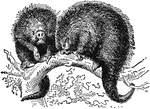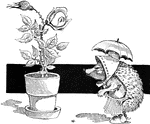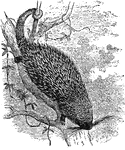Clipart tagged: ‘porcupine’

Brujin's Echidna Porcupine Anteater
A Bruijn's Echidna, or porcupine anteater from New Guinea. The animal have five claws and tapering tongue.…

Globefish
"Tetraodon have a remarkable power of inflating their bodies by filling their stomachs with air, the…

Porcupine
The porcupine is covered in spikes or quills that are its chief defense. If it can't escape, it stands…

Porcupine
A rodent quadruped. It has coarse hair thickly interspersed with erectile quill-like spines, especiall…

Hystrix Crystata Porcupine
"The Porcupine is a rodent quadruped. The North American porcupine is about two feet long, and of sluggish…

Prehensile Tailed Porcupine
"The Porcupine is a rodent quadruped. The North American porcupine is about two feet long, and of sluggish…

Sea Porcupine
"Have a large air-bladder, which they inflate by swallowing air, till they appear almost like balls.…



